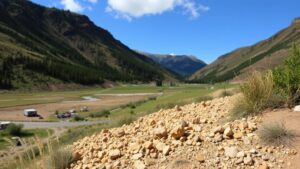Recognizing Rusty Rocks and Their Link to Gold-Bearing Zones
Recognizing Rusty Rocks and Their Link to Gold-Bearing Zones
Geologists and prospectors alike have long recognized the potential significance of rusty rocks, particularly when it comes to discovering gold-bearing zones. This article delves into the characteristics of rusty rocks, their formation processes, and their intriguing connection to areas rich in gold deposits.
Understanding Rusty Rocks
Rusty rocks typically exhibit a reddish-brown coloration due to the presence of iron oxides, most commonly hematite or goethite. This rust-like appearance can serve as a visual clue for geologists and miners when searching for mineral deposits.
The primary origins of rust in rocks can be traced back to several geological processes:
- Oxidation: When iron-bearing minerals are exposed to oxygen and moisture, oxidation occurs, leading to the formation of iron oxides.
- Hydrothermal Activity: Hot, mineral-rich fluids can alter local rock compositions, often introducing iron and causing rusting.
- Weathering: Natural weathering processes can break down rocks and expose iron minerals to oxygen, promoting rust formation.
The Link Between Rusty Rocks and Gold
The presence of rusty rocks can indicate nearby gold deposits due to their association with specific geological environments. Several mechanisms can explain this relationship:
- Presence of Iron: Gold often forms in settings where iron oxides are present, acting as a source of minerals necessary for gold deposition.
- Indicator of Hydrothermal Systems: Rusty rocks may signal the activity of hydrothermal systems that can also transport and concentrate gold. Many major gold deposits, such as those in the Carlin Trend of Nevada, coincide with these systems.
- Alteration Processes: Rocks that have undergone significant alteration, including oxidation, can also indicate the proximity to gold. For example, the alteration of basalt in the presence of hydrothermal fluids can lead to the concentration of gold.
Case Studies and Real-World Examples
Several significant gold mining regions provide clear examples of rusty rocks indicating gold-bearing zones:
- Carlin Trend, Nevada: This area is famous for its low-sulfide, gold-only deposits. Exploratory geologists have noted that rusty rock formations often overlay gold-rich zones, guiding drilling and mining efforts.
- Barrick Golds Pascua-Lama Project: Located on the border of Chile and Argentina, this project has rusty rocks that reveal important information regarding the ore body. Detailed geochemical analysis confirmed a correlation between rusty surface outcrops and subsurface gold deposits.
Probing Further: Geochemical Indications
Also to visual cues, geochemical assays can provide deeper insights into the presence of gold in rusty rocks. Analysis of soil and rock samples for elements such as:
- Arsenic: Often found in conjunction with gold.
- Lead and Zinc: Indicator elements associated with mineralization processes.
These elements can serve as guides for identifying potential gold-bearing zones and refining exploration efforts.
Conclusion and Actionable Insights
Recognizing rusty rocks is not merely an exercise in rock identification; it is a strategic tool for both amateur prospectors and seasoned geologists. Understanding the processes that create these oxidized formations and their links to gold deposits can enhance exploration success rates.
To leverage this knowledge effectively, consider the following action steps:
- Conduct field studies in areas with noted rusty rock formations.
- Engage in geochemical sampling to identify potential gold indicators.
- Use geological mapping to correlate rusty rocks with known gold deposits for targeted exploration.
The world of geology continuously evolves, and recognizing the multifaceted role of rusty rocks in gold exploration is an insightful approach for mineral discovery.



